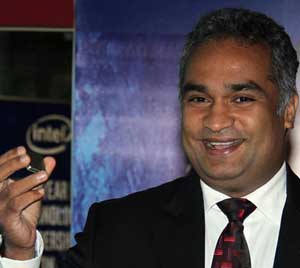Saturday Nov 29, 2025
Saturday Nov 29, 2025
Wednesday, 23 December 2015 00:00 - - {{hitsCtrl.values.hits}}
By Indika De Zoysa
In the world of technology nothing stands still. The rapid pace of innovation we’ve seen across all IT in 2015 will continue into 2016 without a doubt and usher us all into an era of seamless computing. Technology has become a quintessential part of our daily routine and future of computing and technology looks bright.
2015 was a special year: It was the start of an Era of Integration; a time when technology and computational power will no longer be an adjunct to our daily lives, but an integral, immersive and all-encompassing part. In 2016, several major innovation trends are set to redefine technology and computing. The push towards smaller PC form factors offering massive capabilities, the development of new sensory interfaces, and the transformation of everyday objects into smart devices will advance through 2016. Global connectivity will push its way to the forefront of people’s lives and cumulatively, these advances will empower local citizens, and bridge the divide between Sri Lanka and more digitally advanced societies.
No longer do we live in a world with only one device and a basic level of connectivity – now we demand to use multiple platforms, such as smartphones, tablets and PCs, seamlessly and automatically synching together to deliver a truly personal experience. Computing as we know it is transforming, as we move away from a world of screens and devices to one of immersive experiences.
The push towards small form factors
2016 will witness the push towards smaller form factors that blend connectivity and portability with massively improved performance. Intel’s goal over the next year is to expand the stack of 2 in 1 offerings and improve affordability across different price points. This will occur in close collaboration with Asia’s tech ecosystem, particularly local original equipment manufacturers (OEMs) whose innovations add value to Intel designs.
As the middle class expands, mainstream product niches such as 14- and 15-inch notebooks and 10- and 11-inch tablets show continued potential for growth. At the market’s less affluent end, feature phones and low-cost smartphones will remain a vital entry point. A key trend to watch in 2016 is the potential for Intel’s Next Unit of Computing (NUC) and Compute Stick to drive technology adoption as recently launched processors find their way into ever-smaller PCs.
Human senses to change how people interact with devices
The personalisation of the computing experience through sight, sound, and touch is another trend set to crystallise in 2016. Whether in the form of Intel RealSense cameras embedded in devices that respond to human gesture control, virtual reality headsets with Intel’s latest Core i8 processors, or voice-activated smart watches and smartphones; natural interfaces are an inevitable consequence of ubiquitous connectivity.
In low-literacy communities where people struggle to navigate English-language keyboards, the potential to drive technology adoption is immense. Intel RealSense camera capabilities are extending the concept of Human Senses to a whole new range of face- and gesture-enabled experiences. Users of Windows Hello in Windows 10 can already take advantage of facial recognition logins, ending the need to remember passwords. Intrestingly, video gamers can scan their face or body in three dimensions and effectively step inside the screen as active characters, while RealSense video conferencing allows participants to edit and substitute any background they desire.
The Internet of Things will truly arrive
Sri Lanka is a country which is well-positioned to consolidate smart devices through Internet of Things (IoT) technologies. Already, Intel is partnering with private enterprises, telecom providers, and system integrators such as Accenture to understand trends and build solutions. The goal is to help clients connect vital objects in their environment to the cloud – for example, a factory’s security cameras or an entire city’s traffic lights – and securely extract data from sensors. Customers can then generate insights to more intelligently manage operations.
In manufacturing, IoT solutions help companies smooth the production process, minimise machine downtime, and reduce costs. In automotive industry, Intel is working with car device manufacturers to make the driving experience more intuitive – for example, by installing sensors to monitor stopping distance and improve dashboard displays. Transportation and logistics is another growth area, as companies seek real-time tracking of cargo in pursuit of same-day delivery from the warehouse to the customer.
In healthcare, IoT is set to make services more immediate and personalised through wearables, remote diagnosis, and secure prescriptions. Momentum will build in areas such as remote patient diagnosis, secure prescriptions, and wearables that monitor indicators such as a person’s blood pressure or heart rate. Robotics is another area set to expand as more elderly people require monitoring and care.
Cities (and nations) to become smarter
Sri Lankan government has shown keen interest in smart cities which is a very positive sign. Massive urbanisation is the key impetus for governments to undertake smart city deployments. Smart innovation is needed to manage issues such as traffic congestion, air pollution, energy usage, agriculture, and access to healthcare and IoT has a potentially transformative role to play in addressing these issues.
Intel Sri Lanka believes that smart cities will bring more benefits and value to Sri Lanka, encouraging sustainable economic development and a higher quality of life, with sensible management of natural resources through active government participation.
The future is bright
Sri Lanka is set to be a major adopter of computing technology in 2016. Among the middle classes, gadgets are increasingly viewed as status symbols, and younger consumers are swamping social networking apps.
The further penetration of the Sri Lankan market will depend on more attractive pricing, as well as persuading more citizens of the value obtainable from technology. As a new world of ubiquitous connectivity comes into view, Intel is confident that the future of computing is bright.
(The writer is the Country Business Manager of Intel Sri Lanka).